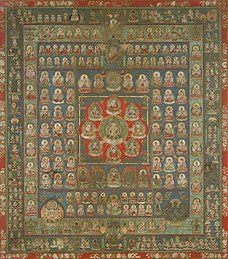Womb Realm
Womb Realm
Jump to navigation
Jump to search

The Womb Realm mandala. The center square represents the young stage of Vairocana. He is surrounded by eight Buddhas and bodhisattvas (clockwise from top: Ratnasambhava, Samantabhadra, Saṅkusumitarāja, Manjushri, Amitābha, Avalokiteśvara, Amoghasiddhi and Maitreya)
In Vajrayana Buddhism, the Womb Realm (Sanskrit: garbhakoṣadhātu, Japanese: 胎蔵界 taizōkai) is the metaphysical space inhabited by the Wisdom Kings. The Womb Realm is based on the Mahavairocana Tantra. The name of the mandala derives from chapter 2 of the sutra, where it is said that the buddha Mahāvairocana revealed the mandala's secret teachings to his disciple Vajrasattva from his "womb of compassion".[1] In other translations, the term matrix realm or Matrix Mandala are used.[2]
The Womb Realm is a very popular subject for mandalas, and along with the Diamond Realm (vajradhātu) Mandala forms the Mandala of the Two Realms. This mandala, along with the Diamond Realm, form the core of Japanese Tendai and Shingon Buddhist rituals, including abhisheka "initiation". In this ritual, new initiates are blindfolded and asked to toss a flower upon a mandala. Where the flower lands helps decide which Buddhist figure the student should devote themselves to.[3]
In traditional Shingon halls, the Womb Realm Mandala is hung on the east wall, symbolizing the young stage of Mahāvairocana.[4]In this setting, the Diamond Realm Mandala is hung on the west wall symbolizing the final realization of Mahāvairocana.
Contents
1 Womb Realm map
2 See also
3 References
4 Further reading
5 External links
Womb Realm map[edit]
Outside Vajra Hall
| |||||||||||||||||||||||
Center Eight Petal Hall
Dainichi is depicted in regal attire wearing a jewelled crown in the center of an eight-petaled lotus. Four Buddhas, representing the four directions, are depicted directly above, below, left, and right of Dainichi.[5] The Buddha of the East, Hōdō, is illustrated on the top, the Buddha of the South, Kaifukeō to the right, the Buddha of the West, Amida, to the bottom, and the Buddha of the North, Tenkuraion, to the right.[5] Four bodhisattvas, Fugen, Monju, Kannon, and Miroku, are illustrated between the Buddhas.[5]
Vajras are illustrated between the petals of nine deities and symbolize the knowledge or wisdom (jnana) that crush illusions.[5]
Four vases containing a lotus and a three-pronged Vajra, are placed at the corners of the Center Hall. The hall is marked off by a five-colored boundary path with each color referring to one of the five buddhas, knowledges, directions, roots, conversions, syllables, elements, and forms.[6]
See also[edit]
- Garbha
- Dhatu
- Vajradhatu
References[edit]
^ Abe, Ryuichi (1999). The Weaving of Mantra: Kukai and the Construction of Esoteric Buddhist Discourse. Columbia University Press. ISBN 0-231-11286-6..mw-parser-output cite.citationfont-style:inherit.mw-parser-output qquotes:"""""""'""'".mw-parser-output code.cs1-codecolor:inherit;background:inherit;border:inherit;padding:inherit.mw-parser-output .cs1-lock-free abackground:url("//upload.wikimedia.org/wikipedia/commons/thumb/6/65/Lock-green.svg/9px-Lock-green.svg.png")no-repeat;background-position:right .1em center.mw-parser-output .cs1-lock-limited a,.mw-parser-output .cs1-lock-registration abackground:url("//upload.wikimedia.org/wikipedia/commons/thumb/d/d6/Lock-gray-alt-2.svg/9px-Lock-gray-alt-2.svg.png")no-repeat;background-position:right .1em center.mw-parser-output .cs1-lock-subscription abackground:url("//upload.wikimedia.org/wikipedia/commons/thumb/a/aa/Lock-red-alt-2.svg/9px-Lock-red-alt-2.svg.png")no-repeat;background-position:right .1em center.mw-parser-output .cs1-subscription,.mw-parser-output .cs1-registrationcolor:#555.mw-parser-output .cs1-subscription span,.mw-parser-output .cs1-registration spanborder-bottom:1px dotted;cursor:help.mw-parser-output .cs1-hidden-errordisplay:none;font-size:100%.mw-parser-output .cs1-visible-errorfont-size:100%.mw-parser-output .cs1-subscription,.mw-parser-output .cs1-registration,.mw-parser-output .cs1-formatfont-size:95%.mw-parser-output .cs1-kern-left,.mw-parser-output .cs1-kern-wl-leftpadding-left:0.2em.mw-parser-output .cs1-kern-right,.mw-parser-output .cs1-kern-wl-rightpadding-right:0.2em
^ Hakeda, Yoshito S. (1972). Kūkai and His Major Works. Columbia University Press. p. 26. ISBN 0-231-05933-7.
^ Hakeda, Yoshito S. (1972). Kūkai and His Major Works. Columbia University Press. p. 44. ISBN 0-231-05933-7.
^ Hakeda, Yoshito S. (1972). Kūkai and His Major Works. Columbia University Press. p. 87. ISBN 0-231-05933-7.
^ abcd ten Grotenhuis, Elizabeth (1999). Japanese Mandalas: Representations of Sacred Geography. Honolulu: University of Hawai'i Press. pp. 60–61.
^ Snodgrass, Adrian (1988). The Matrix and Diamond World Mandala in Shingon Buddhism. New Delhi: Aditya Prakashan.
Further reading[edit]
ten Grotenhuis, Elizabeth (1999). Japanese Mandalas: Representations of Sacred Geography. University of Hawaii Press. pp. 58–77. ISBN 978-0-8248-2081-7.
External links[edit]
Mandala of the Womb World Japan, Kamakura period, 13th - 14th century Dharmapala Thangka Centre
The Diamond and Womb World Mandalas Dharmapala Thangka Centre
Flying Mountains and Walkers of Emptiness: Toward a Definition of Sacred Space in Japanese Religions History of religions 1982
Categories:
- Buddhist philosophical concepts
- Tibetan Buddhism
- Shingon Buddhism
(window.RLQ=window.RLQ||).push(function()mw.config.set("wgPageParseReport":"limitreport":"cputime":"0.332","walltime":"0.410","ppvisitednodes":"value":505,"limit":1000000,"ppgeneratednodes":"value":0,"limit":1500000,"postexpandincludesize":"value":61440,"limit":2097152,"templateargumentsize":"value":20,"limit":2097152,"expansiondepth":"value":7,"limit":40,"expensivefunctioncount":"value":0,"limit":500,"unstrip-depth":"value":1,"limit":20,"unstrip-size":"value":16925,"limit":5000000,"entityaccesscount":"value":0,"limit":400,"timingprofile":["100.00% 273.746 1 -total"," 54.30% 148.644 1 Template:Lang-sa"," 30.84% 84.427 7 Template:Cite_book"," 8.72% 23.863 1 Template:Buddhism_topics"," 7.65% 20.955 1 Template:Navbox"," 1.72% 4.722 1 Template:IAST"," 1.27% 3.482 1 Template:Lang-ja"," 1.25% 3.424 1 Template:Transl"],"scribunto":"limitreport-timeusage":"value":"0.185","limit":"10.000","limitreport-memusage":"value":11965561,"limit":52428800,"cachereport":"origin":"mw2198","timestamp":"20180929152714","ttl":1900800,"transientcontent":false);mw.config.set("wgBackendResponseTime":101,"wgHostname":"mw2231"););

 Clash Royale CLAN TAG
Clash Royale CLAN TAG